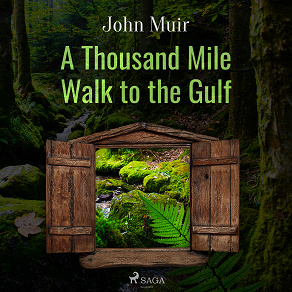
Förlag: Saga Egmont
Kategori:
Romaner
Tillgänglig sedan: augusti 2020
Uppläsare: Mary Ann Spiegel
Length: 4 timmar 5 minuter
A Thousand Mile Walk to the Gulf
In early March 1867, Muir was injured while working at a wagon wheels factory: a tool he was using slipped and struck him in the eye. This accident changed the course of his life. He was confined to a darkened room for six weeks, worried he’d lost his sight forever. When he did recover, the world looked completely different and life had taken on a new meaning for him. Muir later said, "This affliction has driven me to the sweet fields. God has to nearly kill us sometimes, to teach us lessons." From that point on, he determined to "be true to myself" and follow his dream of exploring and studying plants.
A Thousand Mile Walk to the Gulf recounts Muir's walk of approximately 1,000 miles (1,600 km) from Indiana to Florida. He did not follow a specific route, only going by the "wildest, leafiest, and least trodden way I could find." This journal is the earliest of Muir's writings and autobiographically bridges the period between “The Story of my Boyhood and Youth” and “My First Summer in the Sierra.”
John Muir (1838-1914) was a Scottish-American author and naturalist, who is traditionally considered to be the “Father of the National Parks”. Born in Dunbar (East Lothian), he spent his childhood exploring the area, and that is where his love of nature first bloomed. In 1849, his family emigrated to Portage, Wisconsin for religious reasons. At 22, he joined the University of Wisconsin-Madison, from which he never graduated, as he preferred to take a multitude of different classes in the variety of subjects he was interested him, such as chemistry, botany and geology. In 1866, whilst working at an Indianapolis wagon wheel factory, he got into a serious accident and almost lost his sight. When he recovered, he decided to follow his dreams and explore nature. In September 1867, he walked from Kentucky to Florida, later describing the trip in his “A Thousand-Mile Walk to the Gulf.” In 1868, he boarded a ship to Cuba, then later on sailed to New York City, from whence he travelled to California. From there, he decided to visit Yosemite, which he had long read about. He was one of the first to infer that the landscape there must have been formed by glaciers, a widely disputed theory at the time. Muir wrote countless essays, books and letters recounting his adventures out in nature, especially in the Sierra Nevada, which have been read by millions. He played a vital role in the preservation of natural areas, and the creations of Yosemite and Sequoia National Park, amongst many others.
Provlyssna
Information
Stöds av följande plattformar
PC/Mac
Smartphone
